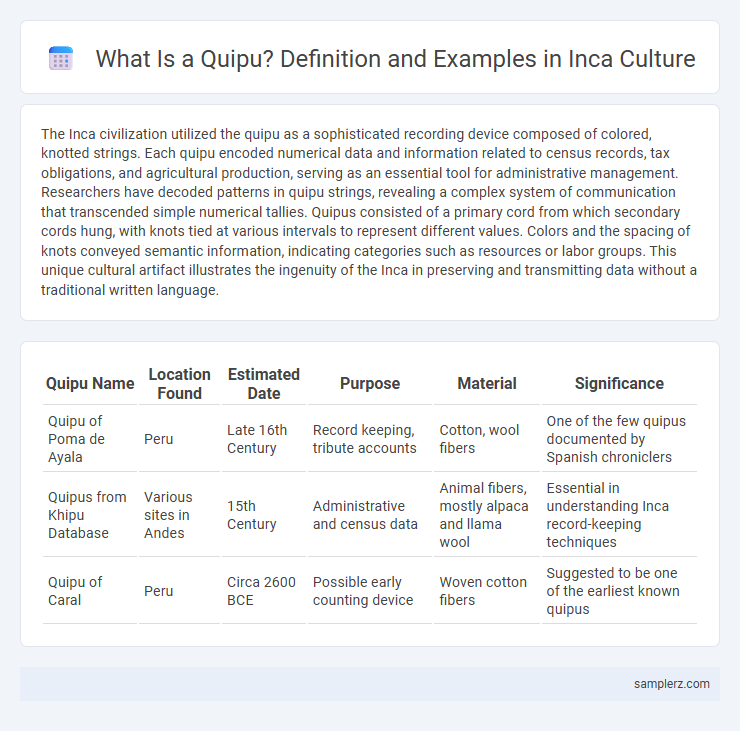The Inca civilization utilized the quipu as a sophisticated recording device composed of colored, knotted strings. Each quipu encoded numerical data and information related to census records, tax obligations, and agricultural production, serving as an essential tool for administrative management. Researchers have decoded patterns in quipu strings, revealing a complex system of communication that transcended simple numerical tallies. Quipus consisted of a primary cord from which secondary cords hung, with knots tied at various intervals to represent different values. Colors and the spacing of knots conveyed semantic information, indicating categories such as resources or labor groups. This unique cultural artifact illustrates the ingenuity of the Inca in preserving and transmitting data without a traditional written language.
Table of Comparison
| Quipu Name | Location Found | Estimated Date | Purpose | Material | Significance |
|---|---|---|---|---|---|
| Quipu of Poma de Ayala | Peru | Late 16th Century | Record keeping, tribute accounts | Cotton, wool fibers | One of the few quipus documented by Spanish chroniclers |
| Quipus from Khipu Database | Various sites in Andes | 15th Century | Administrative and census data | Animal fibers, mostly alpaca and llama wool | Essential in understanding Inca record-keeping techniques |
| Quipu of Caral | Peru | Circa 2600 BCE | Possible early counting device | Woven cotton fibers | Suggested to be one of the earliest known quipus |
Introduction to Quipus: The Inca Knotted Records
Quipus, the intricate knotted string devices used by the Inca civilization, served as a sophisticated system for recording information and communicating numerical data. These colorful cords, varying in length, knot type, and position, encoded census records, resource inventories, and historical events, demonstrating advanced administrative control without a written language. Quipus remain a unique cultural artifact, illustrating the Inca's innovative approach to data management and societal organization.
Historical Significance of Quipus in Inca Society
Quipus served as an essential communication and record-keeping system within Inca society, encoding information through intricate arrangements of knotted strings. These devices facilitated the management of vast administrative tasks such as census data, resource distribution, and tribute collection across the expansive Inca Empire. Their historical significance lies in providing insight into the organizational sophistication and bureaucratic capabilities of one of the largest pre-Columbian civilizations in the Americas.
Structure and Materials Used in Quipus
Quipus, an intricate recording system used by the Inca civilization, consist of a primary cord with multiple pendant cords made from cotton or camelid fibers such as alpaca or llama wool. These cords feature a variety of knots, including single, long, and figure-eight types, which encode numerical and possibly narrative information based on their position, type, and color. The strategic combination of materials and knot structures enabled quipus to function as sophisticated tools for administrative, census, and historical record-keeping.
Deciphering the Language of Quipus
Quipus, the intricate knotted strings used by the Inca civilization, served as a complex recording system encoding numerical and possibly narrative information. Recent breakthroughs in deciphering quipus reveal patterns corresponding to accounting data, census records, and calendrical events, highlighting their function as an ancient semiotic language. Researchers analyze knot types, string colors, and placement to decode messages, advancing understanding of Incan administrative and cultural communication.
Quipus as Tools for Census and Taxation
Quipus, intricate knotted-string devices, served as sophisticated tools for the Inca Empire to conduct censuses and manage taxation efficiently. Each knot and color encoded numerical data representing population counts, resource distribution, and tax obligations across vast territories. These quipus enabled centralized record-keeping and facilitated administrative control over diverse Andean communities without a written language.
Quipus in Mythology and Inca Ritual Practices
Quipus, an intricate system of knotted cords, played a crucial role in Inca mythology as sacred objects believed to hold divine knowledge and cosmic messages. In ritual practices, quipus functioned as tools for communicating with deities, recording offerings, and marking significant ceremonial events. Their symbolic knots and colors encoded spiritual narratives integral to Inca cosmology and ancestral worship.
Preservation and Archaeological Discoveries of Quipus
The preservation of Inca quipus has been crucial for understanding the administrative and communication systems of the empire, with many knotted cords surviving due to dry Andean climates and controlled archaeological excavations. Archaeological discoveries in sites such as the Inca capital Cusco and remote highland regions have revealed quipus with intricate knot patterns, providing insights into ancient record-keeping and accounting methods. Recent advances in digital imaging and analysis techniques continue to enhance the interpretation of these artifacts, revealing the complexity of Inca culture and their sophisticated information management.
Modern Interpretations and Research on Quipus
Modern interpretations and research on Inca quipus leverage digital encoding techniques and computational algorithms to decode their complex knotted structures, revealing insights into Inca administration and record-keeping. Recent studies utilize 3D modeling and machine learning to analyze knot patterns, enabling scholars to reconstruct the quipu's potential linguistic and numerical functions. Ongoing interdisciplinary research combines archaeology, anthropology, and computer science, expanding understanding of Inca civilization's sophisticated communication system.
Comparisons Between Quipus and Other Ancient Recording Systems
Quipus, the Inca's unique recording system, utilized knotted strings to encode numerical and possibly narrative information, differing fundamentally from pictographic systems like Egyptian hieroglyphs and cuneiform scripts of Mesopotamia. Unlike these visually symbolic records, quipus relied on tactile data representation, enabling efficient communication across vast Andean territories without written language. This numeric-based system reflects a sophisticated approach to information storage, emphasizing practical record-keeping over visual storytelling.
Legacy of Quipus in Contemporary Andean Culture
Quipus, the intricate knotted string devices of the Inca civilization, continue to influence contemporary Andean culture as symbols of historical identity and ancestral knowledge preservation. Communities in Peru and Bolivia employ modern quipu-inspired art and textiles to reinforce cultural heritage and educate younger generations about Incan record-keeping traditions. This enduring legacy highlights the quipu's role not only as a communication tool but also as a powerful emblem of Andean resilience and continuity.

example of quipu in Inca Infographic
 samplerz.com
samplerz.com